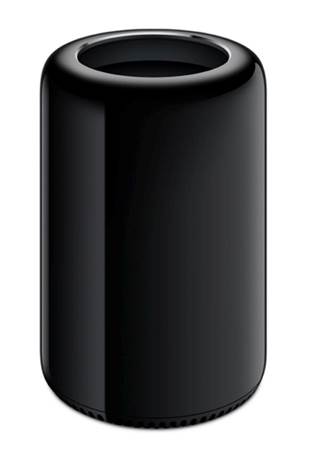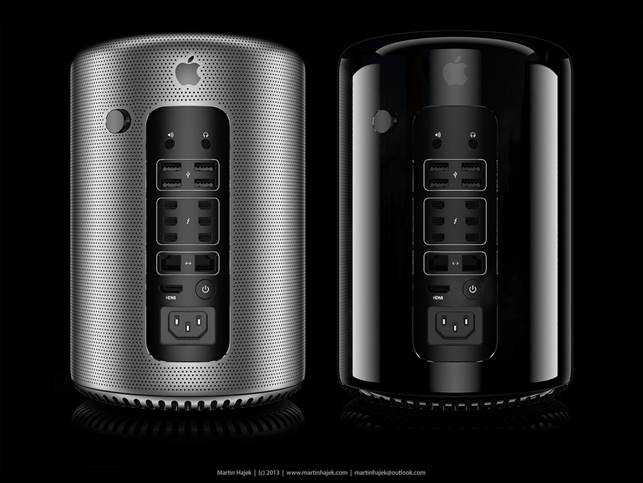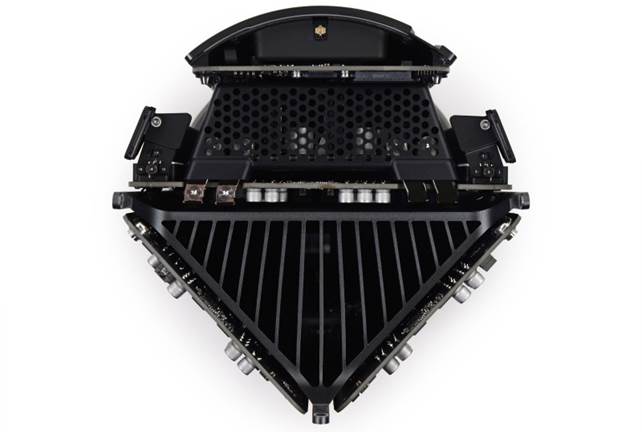The new Mac Pro, introduced at the end of 2013 and still
in short supply, is Apple’s most powerful machine. Its twin AMD FirePro
graphics cards are incredibly powerful and central processing is handled by
lntel’s expensive top-end Xeon chips.

At 25.1cm high and 16.7cm in diameter, the Mac
Pro is astonishingly small; the space it takes up is more like that of a
bookshelf speaker than a desktop computer. It's definitely something to sit on
your desk rather than under it.
Features
Those twin GPUs are the Mac Pro’s standout feature. To buy a
similar pair of graphics cards would cost you a substantial chunk of the Mac
Pro’s price, so it’s great value for money. The catch is that only a few apps
can take full advantage of the dual graphics setup and if yours can’t, you’ll
see little or no benefit compared to a 27in Mac, or in some tasks even a
top-end 15in Retina MacBook Pro. Apple and Adobe-based broadcast-quality video
editors probably stand to gain the most at the moment.
With six Thunderbolt ports, the Mac Pro can connect to as many as
36 high-speed peripherals. There are also four USB 3 ports for cheaper devices where
you don’t need the absolute maximum performance, and two Gigabit Ethernet ports
for networking, as well as 802.11acwifi and Bluetooth. You don’t get a keyboard
and mouse included as standard, unlike with the iMac.
A central feature of the Mac Pro is its extremely quiet cooling
system, based on one huge fan at the top. This makes it well suited to environments
where you need near-silence.
Pros and cons
The Mac Pro is the only Mac that can natively drive 4K- resolution
monitors it handles up to two via Thunderbolt or six regular screens, as well
as one via HDMI (something the latest Retina MacBooks also offer). OS X doesn’t
yet support all the 4K screens that have reached the market: Apple currently
recommends just two, the Sharp PN-K321 and the Asus PQ321Q. The HDMI port can only
drive a 4K display at 24-30Hz refresh rates. One HDMI screen can also be connected
on a Thunderbolt adaptor.

Thunderbolt 2 is the key to how Apple managed
to cram a high-end computer into a tiny cylinder. Six Thunderbolt 2 ports;
There are also 4 USB 3 ports, 2 Gigabit Ethernet sockets, a headphone jack;
built-in audio I/O
This is also the only Mac that supports 64GB of main memory (RAM).
In other respects it’s not so upgradable. Although you can reach all the parts (with
some fiddly disassembly), neither the SSDs nor the GPUs are standard
components, so you’re likely to be limited to Apple-specific upgrades. There’s only
one SSD socket, taking a maximum of 1TB of flash memory. More SSD capacity is
easy to add via Thunderbolt without compromising on speed, but there’s no
realistic way to add graphics processing externally. Thunderbolt does provide a
route to add-ons such as video processing boxes, though.
The theoretical benefit of the AMD FirePro GPUs can’t be
overstated, especially in comparison to other Macs, which all use graphics
processors designed for mobile devices. The Mac Pro is ready to tackle the most
high-end graphics and video work, and Apple’s Final Cut Pro X and Motion 5 apps
can take full advantage. Note that Final Cut dedicates one card to rendering,
with the other largely left to general tasks; how fast it feels in use will depend
on how well this arrangement suits your work patterns.

Usually, cramming so much into a small space
would risk overheating, but the Mac Pro's logic boards are arranged around a
finned prism-shaped heatsink through which cold air is drawn up from the base
by the large fan at the top.
As we’ve mentioned, only a few apps are designed to exploit dual
graphics. That doesn’t mean others will see no gain at all: even one FirePro
beats any other Mac GPU, as we saw in our games tests. On the entry-level Mac
Pro’s D300 GPU, the latest version of Tomb Raider, a very demanding 3D title,
ran at an average of 40.1 frames per second at a high 2560 x 1440 resolution,
compared to 22.5fps for the top- end 2011 iMac (a point of comparison for users
planning to upgrade) and 11.hfps for the current fastest 15in Retina MacBook
Pro with its NVIDIA GeForce GT 750M graphics.
As you’d expect, the Mac Pro’s CPU is also more powerful than the
central processors in other Macs, but here the advantage is smaller. Intel’s
high-end chips lag behind the architecture of its consumer-grade versions (such
as the Core i7 CPUs in the fastest iMac, Mac mini and MacBook Pro models) and
run at lower clock speeds. Even if you pay extra for the 6- or 12-core Xeons,
some CPU-intensive apps, such as HandBrake, don’t run much faster on a Mac Pro
than on a top-spec Retina MacBook.
The Mac Pro does feel very responsive in use, partly thanks to its
flash storage (SSD): there’s no option for an internal hard disk. Compared to
other SSD Macs, it delivers even faster transfer rates: we saw a median write
speed of 738MB/ sec, and 953MB/ sec when reading, with peaks in excess of 1GB/ sec.
This means you can easily work with several 4K video streams simultaneously.
But the maximum SSD size of 1TB, at Apple's somewhat inflated prices, means
you’re likely to be adding lots of external storage.
This is the most powerful Mac by a big margin, but others are also
very capable for almost all tasks, so find out how much your particular apps
will benefit before shelling out.